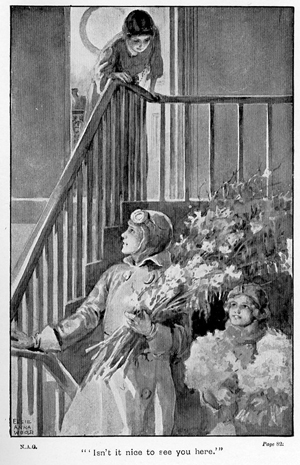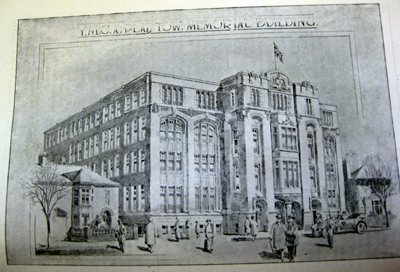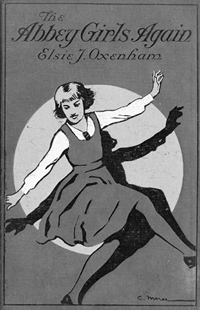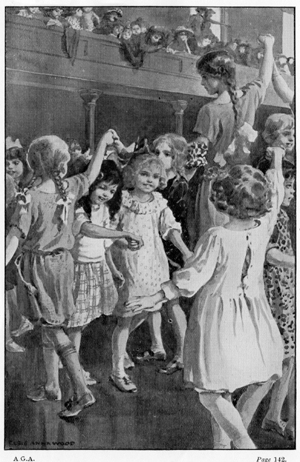|
It is clear from Elsie Oxenham’s books that she visited Daisy Caroline Daking — ‘the Pixie’ — at the Y.M.C.A.’s Red Triangle Club in Plaistow on more than one occasion. In The New Abbey Girls (1923) ‘the Writing Person’ (Oxenham as a character in her own books) says: “I like to go when I can. I feel better for going.” It is Oxenham, therefore, who has left the most tangible record of Daking’s time in East London. In The New Abbey Girls, Pixie has only recently started to teach folk dancing at Plaistow. “The Plaistow men are just beginning; I do feel so pleased about it! It feels just like being in France again.”
The YMCA — opened on 4 June 1921 by the local Labour MP Will Thorne and visited by King George and Queen Mary the same day — is described as “a palace”, a “great white building”, with a marble tablet at the top of the first staircase proclaiming it “a memorial to the men of the district who had fallen in the war”. Facilities included a café, gymnasium, cinema-theatre, billiard rooms, lounge and reading rooms, girls’ and boys’ club-rooms, and a swimming pool. All this in an area that Oxenham describes as having “crowded streets … unemployed men standing at the corners …. squalid houses …. mud and dirt and bustle.”
The Abbey girls watch Pixie taking a men’s Morris class:
However, Jen later asks ‘the Pixie’ why she describes the dancers as men, since they look like boys of no more than 16. ‘That’s Plaistow!’ the Pixie said grimly. … ‘that’s the size and build you are at eighteen, if you’ve lived always in overcrowded homes, perhaps one room or two, and been underfed all your life. … the girls are just the same. … And yet they can take as much and as deep delight in a purely artistic thing like folk-dancing as any of your West Enders. … You should see the joy, and life, and energy in our Saturday night parties! I never saw heartier dancing. And yet they’re City people; shows ‘country’ dancing isn’t really the best name. It’s because it’s folk, of course; folk dancing.’
In the following book, The Abbey Girls Again (1924), the girls return to Plaistow to watch Daking run a children’s party. This is likely to have been a real party run by Daking in March 1923, which was described in the YMCA newsletter of April 1923 as follows:
“The children have been asked through their school teachers, and the teachers have been going all winter to country-dance classes taught by [the Pixie]. The children … are going to dance, in a big, beautiful hall; it’s a swimming pool really, but there’s a dancing floor put down for the winter.” “Small girls in frocks of every rainbow colour filled the hall. Where the frocks, and big hair-ribbons, and white stockings, and coloured shoes, had come from it was difficult to imagine, for the children were from poor schools in East Ham and Canning Town and Barking. Already they were fairly jumping with excitement, racing about wildly to find friends or call greetings to mother up aloft; new groups kept arrive to swell the crowd. The Pixie, a vivid green spot, seemed in every corner at once, like a very active fairy in a world of brilliant butterflies. The pianist played the air of ‘Galopede’, and with a wild rush from every corner of the hall, every child was on the spot assigned to her, thrilled to the limit, desperately determined that not one moment should be lost. “Eight times through!” announced the Pixie,
appearing suddenly on the platform, and piano and violin struck up the
tune. … ‘They dance all over, not just with their feet,’ Mary ventured. … ‘Your real East-Ender dances harder—and almost better—than any one else. It’s curious, but it’s true. It’s in them. They dance beautifully.’ … Oh, look at that! Isn’t it pretty?” as the throng broke up into circling rings of ten or twelve. “Now watch! Look out! … There! Isn’t it wonderful?” as all the little arms went up. “And we clap right on the beat; its very good. How they love it!”
The images above are copyright the estate of Elsie J. Oxenham/Newham Archives/YMCA and cannot be reproduced without permission. Text © Ju Gosling aka ju90 2010
|









 Similarly,
Oxenham writes:
Similarly,
Oxenham writes:
